Our adventure begins
Dear Family and Friends,
We are off on a new adventure. This time to India. For most of our time there, we will be in Delhi and the historic, tourist sights in that greater area. At the end of our trip, we will decompress on houseboats in the south of India (Cochin) before flying home on February 29th.
If you don't wish to get these E-mail, no worries. Please let me know and I'll be happy to fix the E-mail list.
Last night, cousin Annette was in town on business and came to stay the night. Later that evening we picked up Joel and Elaine at the Oakland Airport and drove to Pasta Pomodoro for a late supper.
.jpg)
Annette, Tom, Elaine, Joel at Pasta Pomodoro.
Today the 4 of us ate breakfast at the Egg Shop in nearby Montclair. Afterwards, we dropped Annette off for her business meeting downtown Oakland..
Elaine's sensible breakfast.
Joel, Elaine, Annette and Tom at the Egg Shop
.png)
I will be out of the country while work continues on my kitchen. This is what it looked like yesterday (Feb 3).
Flying to India - Feb 4-6
After a fairly leisurely morning, it was time to leave for the airport. Bob took us to BART to catch the SFO Airport train. It was not busy and we could get on, find a seat and balance our luggage for the 50 minute trip. The train goes into the International Terminal so it was easy to maneuver to check in for Delhi via London.
A new experience for all of us was to fly on the new Airbus A380 aircraft which is a double-decker. Being in steerage, we really never saw how the other half lives. The plane wasn’t full, though if fully configured for one class passengers, it could hold over 800.
After the 9 hour night flight to Heathrow, Tom and Joel checked E-mail.
In London, we had a 4 hour layover, which meant we had plenty of time to make our connection. This flight was full with lots of children. We really didn't mind as we put on our noise-cancelling headphones and zoned out. One thing we hadn’t seen before was shelves that come down in front of the bulkhead seats where the attendants strapped cots for the babies to sleep in. When they weren't sleeping there, they were in their parents’ laps.
This was the flight of the endless night: the 4th in SF, 5th in London arrive in Delhi on the 6th. We arrived forenoon at the Indira Gandhi International Airport, Terminal 3 built in 2010 for the Commonwealth Games. It is a beautiful modern facility. Customs was easy and we soon found our guide and driver to take us to the hotel. They greeted us with marigold leis.
After 8 more hours of night flying (on a Boeing 777) we arrived at the Delhi International Airport.
Nadim met us, gave us marigold leis drove us to the hotel
It was about a 50 minute drive in noontime traffic. The lanes are striped, but our guide said one would be “foolish” to use them. Go where you find a space. They drive on the left and use the horn frequently. It doesn’t seem to help, though.
We arrived at our hotel with the rest of the day free to try and stay awake to get on the local schedule. Before dinner, we went out in search of an ATM at the train station. There was a MacDonald’s there and we stepped into for a look: no beef, just chicken and veggie burgers. Prices seemed to be lower than at home.
In the Lobby of the Jaypee Siddharth Hotel in Delhi.
Our rooms at the hotel look like this.
Day Two in Delhi
Yesterday was our first full day in India after a welcomed sleep. We met the other 13 members of our tour group and had an introductory lecture. The take-away was “India: you will either love it or hate it; there is no in-between. “ We set out at noon by motor coach for the first installment.
First impression of this capital city, officially New Delhi, with 22 million people: it’s run down, dirty with garbage all over the place and infrastructure in disrepair. OK, now that we got that out of the way, let’s start experiencing it.
First stop was the Gurudwara Sikh Temple, the largest Sikh temple in Delhi. This small minority recognized by the men wearing turbans to cover their hair which must not be cut ever after baptism. The Sikh religion is 300 years old and in it all people are equal (for example men and women) and exhorted to do good works. Difficult for some of us was the requirement that we take off our shoes and socks: difficult for someone who can’t walk barefoot across the kitchen floor unless it has just been mopped. We also had to cover our head (no hair showing).
Gurudwara Sikh Temple
Inside the temple, we walked counter-clockwise around a central shrine with a golden camopy under which the "living book” lay. Many people were kneeling, singing and praying.
From there we were taken to a large marble hall (the "common kitchen") where volunteers were donating, preparing and serving food. This temple feeds 15,000 each day. Our first thought was that it was a soup kitchen for the poor and down-and-out. Actually it is a communal meal shared by all. Millionaires and lepers sit down together to share.
Joel (orange head scarf) at the Gurudwara Bangla Sahib Sikh Temle in Delhi
Cooked Rice!
Elaine checking out the lentils
Chibata bread dough
Frying chibata bread
Curry
Preparing the hall for the next sitting/serving
With precision, the people came in (at least 750 in a sitting and sat on the floor in long rows, back to back and facing others in the next row. Spoons and large metal trays were passed out and after prayers, people began serving a full meal. Elaine and several others passed out chibata (bread). In about 40 minutes, the people take their trays and utensils and wash them, the floors are swept and the runners re-arranged and a new group is ready to file in and it starts again.
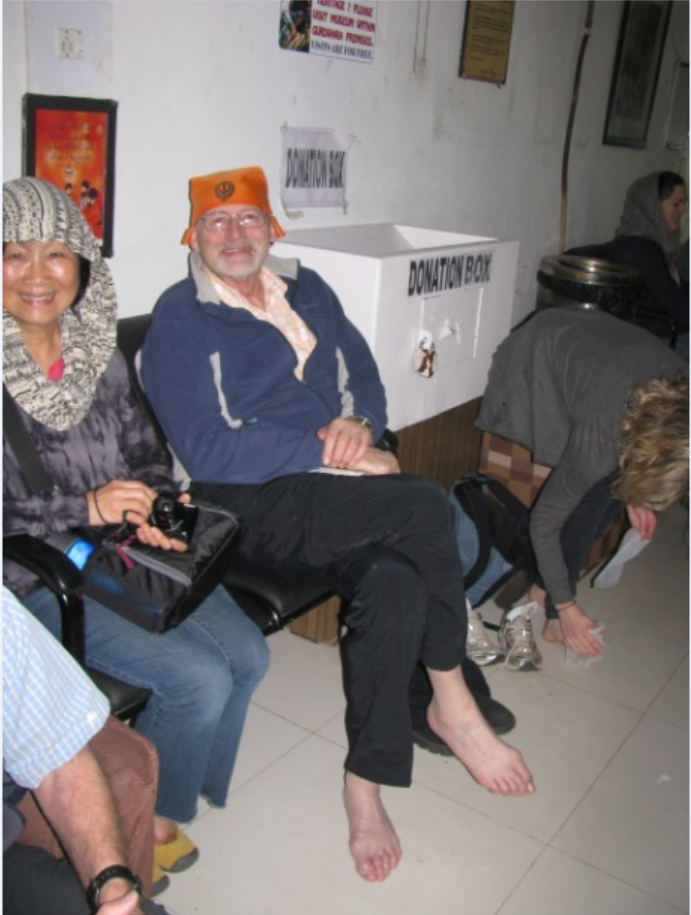
Min and Tom with hair covered and feet uncovered.
Though we decided not to eat here, it was a very moving experience.
Next stop, was the Jama Masjid the largest Muslim Mosque built in the 17th century by Shah Jehan, who also built the Taj Mahal. When India was partitioned at independence in 1947, the country of Pakistan was established as a home for Muslims. Ironically India has a larger population of Muslims, second only to Indonesia. Muslims are more liberal here than many places in the Middle East, and most women don’t wear burkas and are allowed in the temple.
Back of Jama Masjid Mosque (Largest in India)
Here we needed to remove our shoes, and women put on a covering (like a thin, colorful robe). It was intended to make sure that knees and elbows weren’t showing. It was easier to just give every women a robe than to go through lengthy explanations of these customs, in many languages. Men were given a length of cloth to wrap around their waists if they had on shorts.
Here local people came up and asked to take pictures of us or to be in a selfie with them. Our guide said that we are an oddity (white faces and grey hair) to them.
Afterward we transferred to rickshaws and were pedaled through the narrow old winding streets. It was mostly a wholesale market. Most shops were closed since it was Sunday.
To get to the rickshaws, some of us walked through an outdoor flea market. There seemed to be many vendors selling seconds of new men’s clothing. The area was mobbed and we slowly edged through crowds of people.
Tom and Donna on a Rickshaw Ride through old town/bazaar
Our guide Prabhu said that to cross the street you just need to step out and go. Car, motorcycles and tuk-tuks would go around you like a river. He, who hesitates is lost. Well….. that’s one way to look at it. Prabhu also told us when we queue up, we need to stand very close to the person ahead of us or it is assumed that you are NOT in line. Here, people don’t say "please" and "thank you" and "excuse me" much. No need to waste time with those niceties.
Mahatma Gandhi was assassinated in 1948. We were taken to the site of his cremation, there is a beautiful park and memorial. Hindus don’t believe in memorials, but something had to be done for the father of their independence. He thought if anything were done for him, it should be a place that all people could enjoy. The trees and flowers are beautiful, and it was built in a reclaimed wetlands where the river used to be.
Gandi Cremation Site
Gandi Cremation Site Memorial/Eternal Flame
After these last intense few hours, it felt good to relax at a very nice restaurant where we were served a wonderful Indian meal. Lots of highly spiced small dishes with lentil flour bread, thin and crispy and flat wheat bread (nan) baked in a tandoori oven.
The plan was that we would take the Metro back to the hotel. Delhi has a new popular subway system. It will grow to three times in the next several years to help alleviate traffic.
When the train came, we were literally pushed into the car and found ourselves wedged a little way from the doors. We needed to go 4 stops, and I could see that few were getting off at the intervening stations. In fact a few more were getting on. We could see that it would be a problem to get off. I said something to Elaine and some young men were smiling at the predicament. Miraculously, we were expelled as the doors kept shutting and opening and hands were outstretched to pull us out. Whew, we all made it.
Our hotel was only a couple of blocks from this station. We were told that the traffic was light since it was Sunday. We can see the elevated trains running every 2 minutes right after the other outside our hotel window. We fell into bed and were instantly asleep.
India Gate - War Memorial to the Indian soldiers who fought under the British in World War I.
Electrical Phone Wires. If you are a lineman, you have a job for life.
These guys wanted me to take their picture!
Day Two in Dehli and Jaipur
To add a little spice to our travels, one of our immediate party had a minor mishap. When he set out his suitcase in the evening to be sent to the next city, he didn’t keep back a pair of pants. Neither did most anyone else. He improvised by wearing a fleece jacket upside down with the sleeves for legs. A new fashion statement was born! Especially handy was the neck hole between the legs. The presentation added immeasurable to the morning’s entertainment until Bill came by with his emergency stash of clothes. Pictures at a later date.
Our next experience was a nice drive through the very impressive government buildings in New Delhi which house the Parliament, the Supreme Court and the President. They are huge sandstone structures dwarfing any in Washington. On the way back we drove down a wide boulevard lined with embassies including United States.
Capital Buildings in New Delhi
Our tour bus
We headed out of town for a visit to Qutab Minar, a spectacular example of Indio-Islamic architecture. This was in the time of the Muslim invasion into India which resulted in the overthrow of the Delhi Hindu rulers. The conquerors built an impressive mosque and 235 foot tall minaret. Faced with sandstone, the structure has lasted for nearly 1000 years despite being in an earthquake zone.
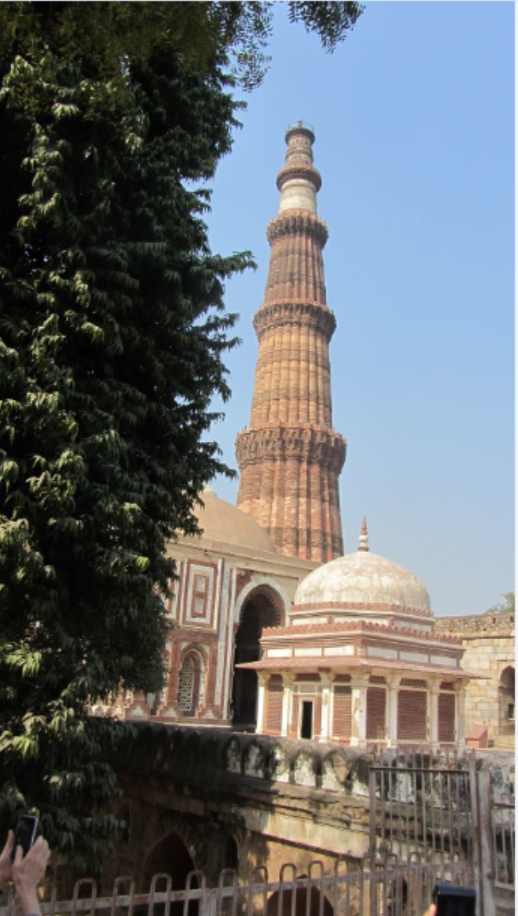
Beautiful tower (Minaret)
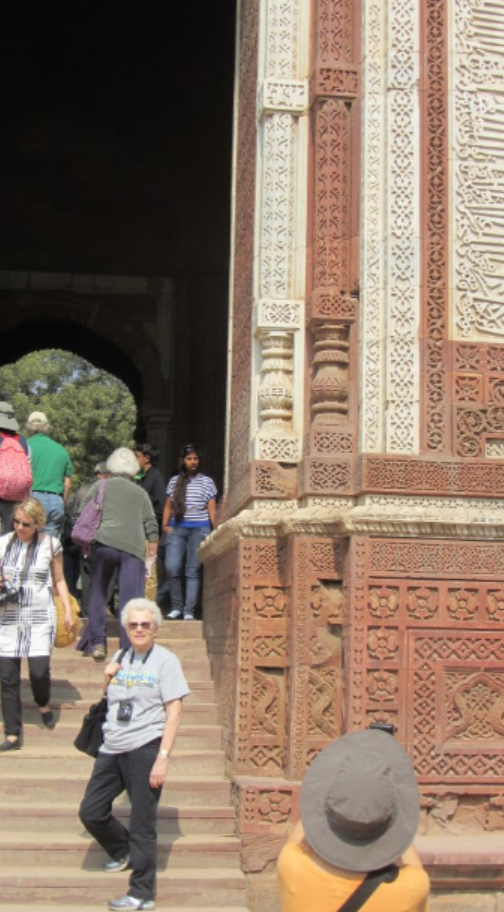
Old Mosque Museum
It was a busy day since we had to get to the airport for a short flight to Jaipur. We arrive in the evening and were happy to crash when we reached our hotel.
Street Barber
We awoke to a big day of activities in and around the Pink City, built by King Jai in the 1700’s. Our drive through the gates was spectacular as the walls still stand and are beautifully decorated. Our destination several miles out of town was the former locations of the kings, the Amber Fort and palace. We transferred into jeeps for the final part of the journey over a very rough cobblestone road. The vistas were breathtaking. In its glory, there would have been jeweled walls and wonderful carved and inlaid marble. There was a procession of elephants carrying tourists through the public courtyard. Monkeys climbed around the walls and near us one jumped onto a lady, tore off her marigold lei and began to eat it.
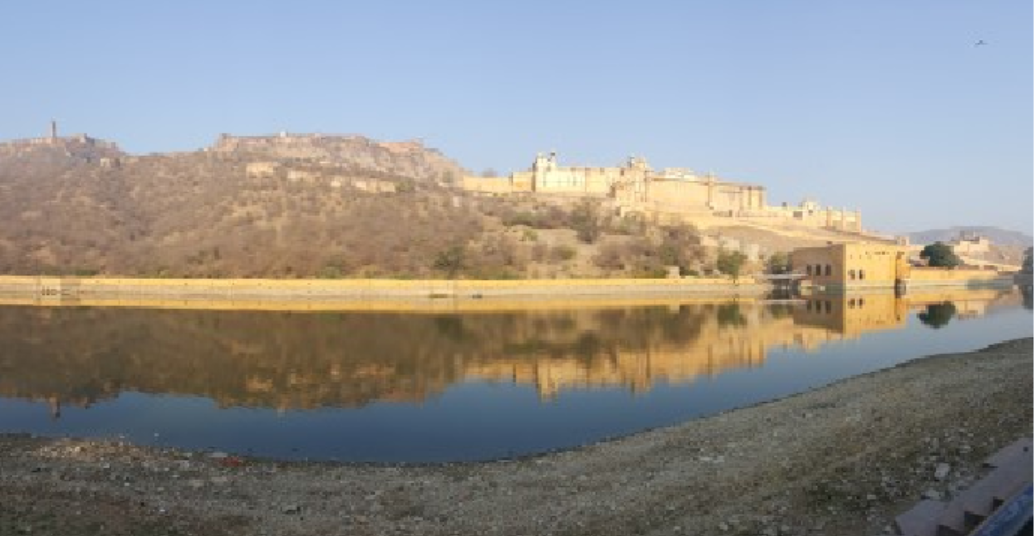
The Amber Fort in the distance
The long tail monkeys steal the marigold leis and eat them
After a thorough tour by our able guide, Prabhu, we headed back into Jaipur to visit the palace and museum. After the new city was built the king and court moved to it from the Amber Fort. It was designed for 300,000 people with wide boulevards. It now has 3 million. From the palace it was a short walk to the world’s largest sun dial and observatory built in the mid-1700’s. Following the stars and charting horoscopes is very important to Hinduism. We were told that when a marriage is being arranged, the astrologers will be consulted to make sure the couple will be compatible.
Picture of our group with other tourist in Saris
Please pay me to take my picture
Courtyared of Amber Fort - Elephant rides in distance
Picturesque Palace in man-made lake
Rice cooking pot used at the fort
in the olden days
Tourists in saris
By the way, we were glad to hear that all the garbage we saw everywhere in Delhi was the result of a strike by garbage collectors. It’s much cleaner in Jaipur. Today as we were coming into town, Prabhu picked up a 10 year old boy who performed some magic tricks for us on the bus. He did a nice job and we tipped him. Prabhu thought it was better to have him perform and earn money rather than to beg. It would give him confidence to do more with his life.
Public convenience for men.
In the evening we went in smaller groups to private homes where we had a home-hosted dinner with a family. Our family was a father, mother, boy and girl who had moved from the village for a job. In the village. In the city there are more opportunities for work and education. They go home where they live with their large extended family as often as they can. He works in the travel industry working with palaces that are being converted into hotels, think Marigold. She stays at home. Fresh vegetables are delivered daily and milk comes morning and evening to the home. They make yogurt and cheese. She invited us into the kitchen as she prepared the meal. It was very nice including bread just baked from wheat from the farm they had ground.
Home Host Pavon Family
Host family's kitchen - spices
Home hosted dinner
As we are off today to stay in a tented camp for a country festival, you will be relieved toknow we won’t have internet for a couple days.
Nagaur, India– The Cattle Fair
Before our journey continues: Columbia Sports Wear.

Columbia Fleece Jacket ... When you forget your pants!
Early in the morning we left Jaipur for a bus trip to Nagaur, about 200 km away with a population of 500,000. We were prepared for a bumpy twisty ride through the countryside heading west. The first part of the journey turned out to be on a 6 lane toll road that was better than most anything we have at home. Sometime later we turned off onto a secondary 2–lane road. That was a different story. Sitting on the aisle one could look up ahead and somehow stay calm as a truck was heading straight toward our passing bus. There might be a motorcycle with 3 or 4 riders and/or an oxcart. Might makes right and buses often trump a truck. Cars and bike would often have to move over to the parking strip. One wouldn’t have wanted to have a hand between vehicles.
We turned onto a smaller road just as we got to the area where there are large granite and marble quarries. There was yard after yard of slabs of stone that went on for miles. Prabhu thought the marble cost about .25 cents a sq. foot. No wonder the hotel where we were staying had granite and marble floors and walls in the rooms
Many, many granite/marble companies
As we got closer to our destination the traffic thinned. Occasionally we passed camel carts and herds of camels going toward the fair. It is not unusual for them to come from 100 miles away. These are held in different parts of the country and this one is in late January or early February, and it lasts for 10 days. Our travel company has contracted with a group to set up a campground for a number of its groups coming through to take advantage of this festival. There are 80+ tents with beds & bathrooms and there is electricity during certain hours. We’re told that it took 30 days and 30 workman to set it up. It will be used for 10 days then torn down again. There is a dining tent, and an area for evening fireside performances of local musicians and dancers. It is desert and dirt, but they have planted a strip of green wheat along the reed mat walkways that is about 6 inches high.
.jpg)
Our tent cabins
Dinner in the dining room tent (Joel, Mary and David from Berkeley, Tom)
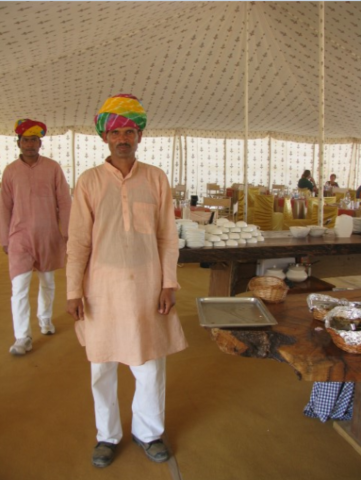
Dining Room at the Aagman Camp
.jpg)
Bathroom in tent cabin
70 or 80 tents in the Aagman Camp
For the afternoon’s experience, Prabhu took us on a long walk through the camels. He would stop and talk to the people who had brought the animals to sell. The carts are wooden and use cast off airplane tires on a wooden axle. The tires are bog and work well in the sandy desert. They will have tents and camping gear with them. They were had fires and were cooking. This fair is definitely a working fair for the benefit of the local people, not for tourists other than observers like us.
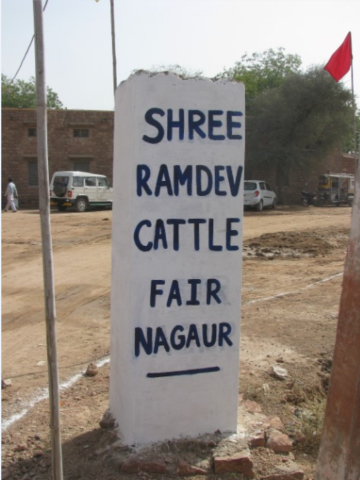
In the morning we were awakened to the Muslim call to prayer, and after a leisurely breakfast, we were off to walk through the cattle and horses. As you probably know, the cow is sacred in India and therefore not eaten. However, that doesn’t mean that they’re not used for all sorts of things. The milk is used for butter, cheese and drinking, the hide is for leather goods, the bones are ground up for fertilizer, etc. In former times, the bulls or steers were used as beasts of burden, but most farms have tractors now. So those animals wander around, and may be lying in the street as you try to pass. People will feed them for good “karma,” points earned for the next life. Prabu said ay house the first two loaves of bread (flatbread) baked each day were for the dogs and cows. They would learn what time of day to come around and get their bread. Then they would move to the next house. Hindus view eating beef as the same as eating your seed crop. Joel had a “tenderloin” hamburger at the hotel and was told later that it would have been water buffalo.
Camels for sale
Camel traders
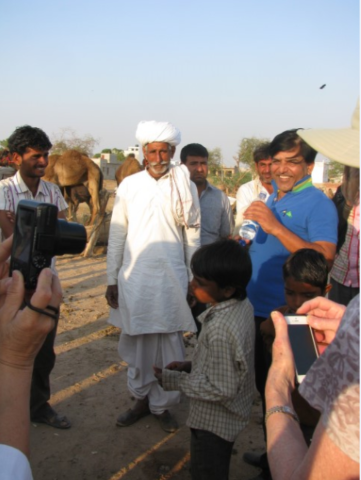
Talking to Camel trader (Prabhu our guide in blue shirt)
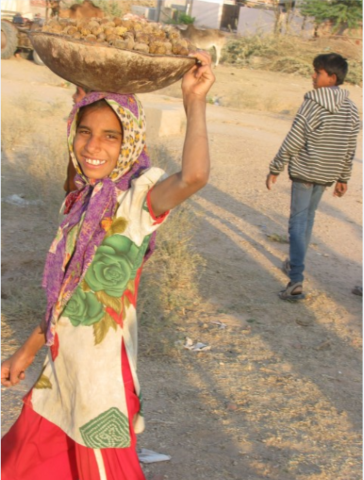
Girl collecting dung to use for cooking fuel at the animal fair
Cattle for sale
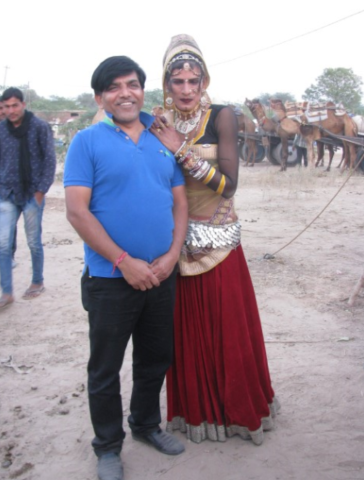
Transvestite dancer to perform at a wedding ceremony tonight.
Decorated camel (careful haircutting plus dye)
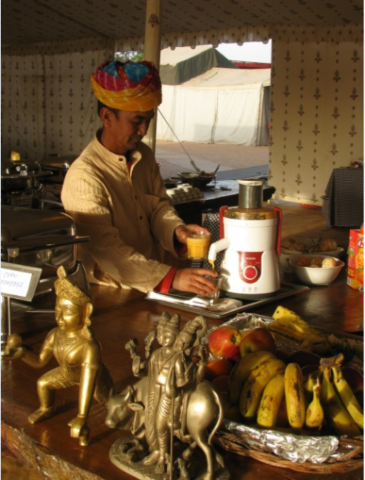
Smoothies for breakfast, made to order.
Buyers and/or sellers making millet bread (white disc in black pan) for lunch
We saw beautiful animals. White horses are a specialty used for the groom to ride the last distance to his wedding on a white horse. The bride is waiting for Prince Charming, whom she may never have met before, to come riding on a white horse. Trained dancing horses go for a lot of money. On one day in Delhi, there can be as many as 28,000 weddings—lots of horses. An O.A.T. staffer from Delhi said the only time he had ever been on a horse was at his wedding and it scared him to death.
Cows may also be collected and shown as special animals complete with very colorful blankets usually with a pouch on the top for the hump. Most are Brahma-type. We stopped to visit with a gypsy family who are nomads. The men and women wear all their wealth in solid gold and may be worth tens of thousands of dollars. This large family moves from village to village making farm implements such as grub hoes out of scrap metal. They may stay about a month then move on. The woman was making flat bread and frying it. She kneaded flour and water together and patted it into a circle. Then she put it onto a piece of steel over a fire. In a pot she made some kind of curry with vegetables. Lunch. Or dinner or breakfast.
White horses used to carry groom to his wedding ceremony.
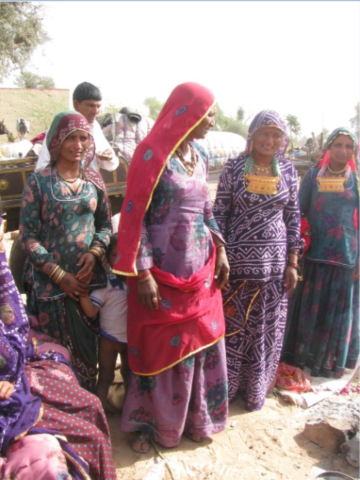
The gold jewelry worn by women of a nomadic tribe as a way to "bank" their cash.
Kids were always wanting their pictures to be taken
Ellen in our group has a Fujji Polaroid camera and she took some pictures of some women and children. The word went out and soon there were dozens of kids wanting one. They seemed to think all of us could give them one from our digital cameras. In a few cases there was begging, but sometimes it was hard to know what they were asking for, except chocolate, we understood.
The temperature is in the 80’s during the days but cools down rapidly at night (50s). When we got back to our tents, it was a pleasant surprise to find a hot water bottle in our bed.
This afternoon, we went for camel rides around the fair, some in the saddle and some in carts. A little bumpy. Some visited a charity that is a hospital and hospice for animals. We sent Elaine to take pictures and report back.
Joel, Elaine and I opted for the camel cart ride
Elaine celebrated her birthday the day before. After dinner there was a beautiful cake for our group and Prabhu had a card his wife had made. We learned yesterday that in Hinduism, the last quarter of one’s life is free from all responsibility. Elaine joins Joel at this stage. Traditionally, a person this age bids farewell to his family and heads for Varanasi with no possessions depending on charity all the way until he dies and has his ashes scattered on the Mother Ganges.
We are soon headed for Varanasi!
Return to Jaipur
(Our guide pronounces this city "Jay-pur"
Today we left all the animals and began the journey back to Jaipur for one night. As we drove away, we saw the scope of the fairgrounds, and it is huge. There is not much by way of sanitation, but there were walls and bushes all around. We were amazed to see scores of camel carts still on the road 50 miles away heading to the fair. Often owners were walking and leading the animals.
Camel Necklaces
After checking in at the hotel, we drove to a restaurant for lunch. Surprise! It was Italian. A very nice change from curry, although the three of us really like curry (luckily). Our Indian menu always has flat breads (naan - oven and chapatti - fried - often with charred parts), chicken butter curry, masala seasoned dishes, and always lentil soup. Mostly it would be spicey hot, even though they try to tone it down for us. Hot sauce is always available.
Spaghetti at the Townhouse Restaurant
After lunch we drove to the old town of Jaipur, behind the walls passing by the Palace of Winds which looks like the façade of a building, but is a wall of screened windows which royal women could ascend stairs and look out incognito at the passing scene on the street.
Palace of Wind
(Hawa Mahal) in Jaipur
We went to a market area, a long covered sidewalk that went on for a half mile or so. Prabhu told us that in most families the men buy the groceries since parking isn’t easy and many women don’t drive. This area had lots of women’s saris for sale as well as bracelets and rings and women to come to this area for. In the sair shops, saris where customers would sit and have the brightly colored material laid out for examination: silk, cotton and wool.
Buying Saris
Spices
This is the old city that although it was designed in the late 1720’s is on a grid system with streets at 90 degrees. This part of Jaipur hasn’t changed much except for a subway metro system being dug along the main streets.
Painted elephant walking down the street
For us, it was push, push through the crowd while looking at lots of interesting stuff. We are always an oddity and older boys especially would speak to us, or maybe giggle at our white skin, sun hats and sun glasses. Sometimes they would want their picture taken or to take ours.
From there we went to the textile factory where block printing, weaving and spinning was demonstrated. We were ushered in to the carpet store where beautiful wool, camel hair and silk carpets were on display. They would gladly ship them to us, and some of our group did some buying. We won’t be waiting for any packages to be delivered.
Block printing on fabric
Wool, camel hair, silk, cotton carpets
As we boarded the bus to go to dinner, we found all the curtains closed. We were warned not to open them. What? A terrorist attack? No! we were having a party with some Indian vodka and scotch. In India the drinking age is 25, and it is not permitted to drink in public. It need to be in a licensed establishment or in the home. The bus wasn’t licensed. It was fun and got us ready for the next adventure.
We learned that the day was auspicious for weddings. For some reason on this day you don't have to pay attention to the horoscopes for best wedding day. We ran into wedding parties wherever we went. There would be brass bands, over the top costumes and of course the glittering groom on a white horse. As we were leaving for dinner, we passed a wedding venue and the bus stopped to let us out. We crashed the wedding and saw all the beautiful decorations and lights. (Actually the hosts invited us to come in.) The groom was there and we learned the bride would be coming in about an hour for the ceremony. We were greeted like long lost cousins and soon bid our goodbyes and best wishes.
Groom on white horse
Stage for wedding ceremony
Wedding guests
Prabhu said that often in a town the wealthy will go together and throw a mass wedding for poor families. He went to one where there were 51 couples, and it was held in a stadium with 5000 guests. However, the 51st horse was rider less due to the cold feet of a groom. He had run away. The bride and family were still anxious to have her married, so someone stepped up to the mike and asked if there was any young man who would like to get married. Someone stepped up and after 30 mins. or so of negotiation, he was up on the horse.
Entrance to wedding venue
Ranthambhore National Park
(Up early again for departure.) Our destination is a hotel called Nahargarh at the Ranthambhore National Park. Nahargarh means Tigers’ Fort. We were on the bus again for a rather bumpy ride on secondary roads 140 miles due south of Jaipur.
Before we got very far, the bus stopped and a man got aboard. Bill in our group had purchased a Nehru jacket, paisley vest and shirt the evening before. It was supposed to have been sewed up and delivered to our hotel in the morning but it hadn't shown up. The outfit was tried on in the back of the bus, given the thumbs up, and we were on our way.
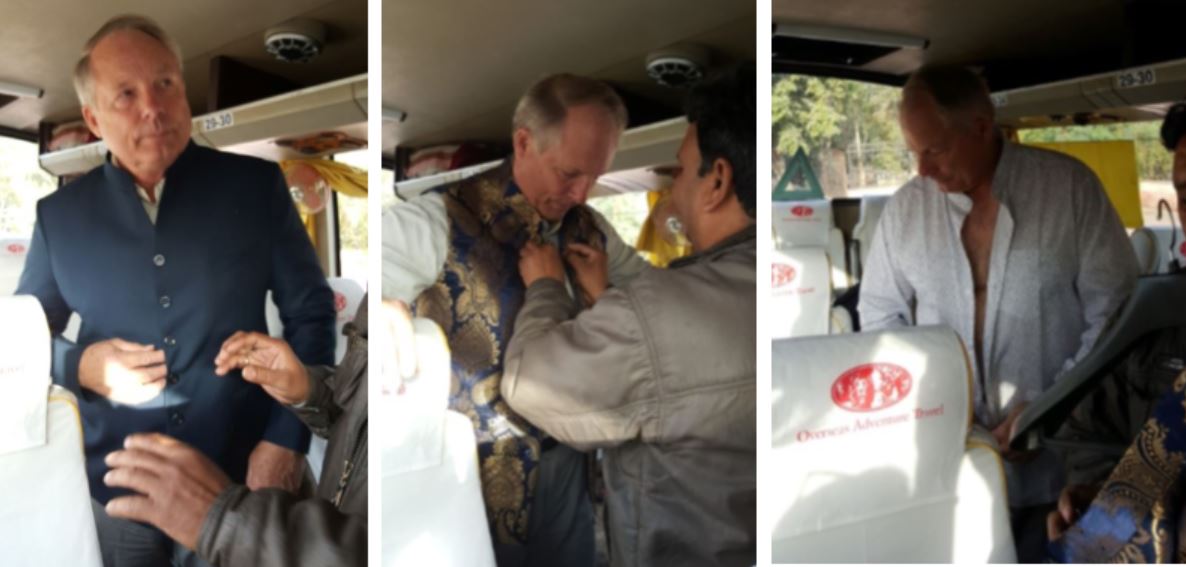
Bill trying on his custom-made jacket, brocade vest and shirt.
We made a half-hour stop in a town along the way and walked through a bustling market. We walked through the stalls of beautiful produce and food. It was definitely not a tourist destination, though we felt welcomed. At a tea (chai) stall, we were offered hot tea. It made some of us a little nervous, so Joel, Elaine & Tom refrained,but others pronounced it the best they'd had. Masala chai is an Indian spice tea served with milk and sugar.
Joel lingered behind and a man picked up a fruit looking somewhat like a kiwi. He cut it up for him, but Joel just had to decline. It was not peeled. Several of our group have had “Delhi Belly” and fortunately it hasn’t been long-lasting. We rely on our guide to give a thumbs up or down.
The cows like to lie on the median where it is warmer on these cool winter mornings. In this area the surrounding countryside is lush and green from irrigation. We see wheat, anise, mustard and guava orchards. There will probably be another crop in the monsoon season of June-July. The fields will be dotted with women in bright colorful saris.
Sweets for sale along this narrow street
Potatoes, radish, green peas, carrots and cauliflower at local market
Red carrots at market. We haven't see orange carrots here ... just red ones.
We had an interesting experience at a railroad crossing where the gate was down. These gates were manually lowered and raised. We got out of the bus to "use a bush" and wait for the train. Apparently the tracks are divided into zones. When the train enters the zone, all the gates go down. We had to wait about 10 or more minutes. In the meantime cars filled up all the lanes coming towards us and on our side the lanes were full of cars pointed towards them. The guide and driver were laughing about how much fun it is when the gates go back up and traffic has to dodge this way and that to get going again.
Labor is rather inexpensive here, and there is always a lot of help. In addition to our guide, there is a driver and his assistant to greet us with praying hands and “Namaste,” my soul merges with your soul. Good for hello, goodbye, good afternoon, good evening, thank you, etc. We haven’t figured out how to put my hands together in greeting while carrying baggage. Joel wondered if a one-handed Namaste is like one hand clapping.
Looking like a maharajah’s palace, our hotel the Alistair Nahargarh Hotel, is located near the Ranthambhore National Park entrance. We got to the hotel just in time for lunch and check in before a hike to the Ranthambhore Fort. Elaine, Tom and Joel elected not to do this excursion since it was a chance to relax, send out laundry, etc.
Alistair Nahargarh Hotel
"Our" Courtyard at Alistair Nahargarh Hotel
It’s nice to have some time in such beautiful surroundings. Although this palace is relatively new, it was built and is owned by the maharaja and they have gone to great lengths to make it look like a palace. The rooms have brass locksets with padlocks. The bathroom Elaine and Joel have is larger than some motel rooms they’ve stayed in. There is a large dining room where everyone eats. Our travel group has its own table. We could go swimming if we liked, in the beautiful pool with elephants spouting water out of their trunks. Some have had massages.
Dining room at Alistair Nahargarh Hotel
Alistair Nahargarh Hotel
Main courtyard at
Alistair Nahargarh Hotel
.jpg)
Room at
Alistair Nahargarh Hotel
.jpg)
Room at
Alistair Nahargarh Hotel
Bathroom at
Alistair Nahargarh Hotel
.jpg)
Elaborate swimming pool and lounge area with massage and spa facilities.
Tiger Hunting
We are up early for the first to 2 tiger seeking treks into Ranthambhore National Park. The park is split into territories and different vehicles/guides are assigned specific areas to drive in. The night before we watched a video of tigers in this park.
Watching the "tiger" video the night before our hunt.
The problem with finding a tiger is that they are solitary beasts who claim their territory perhaps as large as 50 square kms. Therefore it is hard to spot them. Sometimes they will be lying in tall grass and you will only see a tail swish. After eight hours driving over very bumpy roads, we didn’t see even that.
Majsar, our guide
Our group on the large safari vehicle
Arched opening under a banyan tree
Fresh female tiger's paw print
We did see hundreds of deer of various varieties and scores of varieties of birds. One that came and lit on you was a rufous tree pie, similar to a magpie. There were parrots and parakeets as well. And the monkeys. There is a symbiotic relationship between many of these animals. The monkeys climb the trees and eat leaves shaking food down two be consumed by the deer. We are in the dry season and as it progresses toward monsoons in the summer, the food supply lessens.
Wild boar
Langur monkeys
There is a big effort to protect the tigers. In the time of the maharajas, there were 40,000. For all the hunting, the number never waned since only the males were killed. Since independence in 1947, the number has declined to 3,000. Indiscriminate poaching has caused this. Now, poaching is a life sentence though still practiced since a tiger will bring 2 million rupees, $28,000. Rhantambhore is a national park and tiger sanctuary, and has 40-60 tigers. Naturalists are working hard to preserve them. Occasionally one gets in a village and some people have been killed. In one case, the tiger had to be removed to a zoo-type environment due to the outcry.
Spotted deer
Wild peacock ... the national bird of India
Honey bee hive hang from a tree. It was damaged and the bees were rebuilding it. There was another hive in the same
tree, but wasn't as photogenic.
Ranthambhore Fort
It was another lovely evening with the musicians in the courtyard playing traditional music. From friend and correspondent Susan who took this trip a year ago, we understand they are a father and son. They are up by breakfast and still there when we retire at night. The father plays a stringed instrument and the boy dances and twirls.
Our hotel in the distance
Most of us sent out laundry and it came back that evening all folded and ready to pack. After all the dust of the safari, we needed some fresh clothes.
Apologies for some of the proofreading errors in our posts. This is a community effort and some nights it’s easier to fall into bed at an early hour than to re-read what has been written. We try to collect and download the hundreds of pictures each day and find some good ones to send out. We are seeing so many interesting and colorful things that we can’t stop clicking. People are so willing to have their pictures taken; their frowns are just their way of posing.
Drinking tea in the courtyard
Joel unlocking the padlock and opening the latch to his room.
India is the second largest country in population, 1.2 BILLION people. We have 3 times the land area with 400 MILLION. Our leader was telling us about attitudes toward garbage and litter. He said he was an adult working as a guide hiking in the pristine Himalayas before the concept of littering was called to his attention. Everything that has use is purchased back: glass, metal, plastic, paper, etc. Items with no use are cast aside (poly shopping bags). The Prime Minister has started a new campaign to clean up India. He invokes Gandhi’s teaching about cleanliness as a guide and the symbol is a pair of wire-rimmed glasses. It is being taught in school. It’s a huge cultural change.
To continue to read about this adventure, please click here.